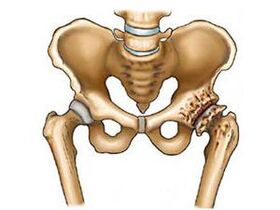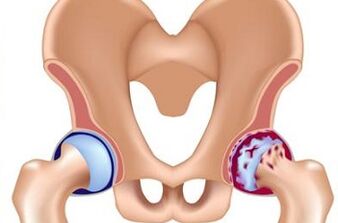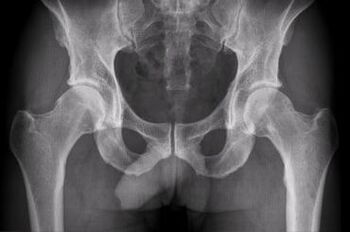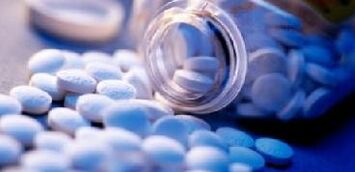
The osteoarthritis of the hip joint (coksarrosis) is a chronic and gradually disease that progresses, in the absence of timely and adequate treatment, it can cause a complete loss of movement in it.The end suggests that an inflammatory process does not prevail, but a degenerative process.
The symptoms of this disease differ according to the stage.At first, this is a barely remarkable discomfort that occurs when walking and physical exercises.Perhaps the manifestation in the form of weak pain in the thigh, which passes.In this case, pain can be felt not only in the thigh, but also in the groin or knee.
As a general rule, coxarthrosis is a process that is being filtered for many years, characterized by a gradual change in the cartilage, followed by the deformation of the bones and the loss of joint functionality.Most people who affect people after 40 years, but are also very young patients.
Causes
Why does the osteoarthritis of the hip joint occur and what is it?The causes of coxarthrosis can be different, but the image of the disease is always the same.It all starts with changes in joint cartilage, which is thinner and loses the property of amortizing loads.The body compensates for the stratification of cartilage tissue by forming bone growth along the edge of joint surfaces, which leads to the deformation of the joints and bones of various degrees.
The main causes of this joint disease:
- Injuries.This cause may not be an important lesion, but in many cases, chronic micro -traumas affect the development of the disease that contributes to the cracking and thinning of the cartilage.They also affect the anguish of the articular capsule, which leads to the accumulation of many damages.Often, repeated microtraumas are the precursor of the appearance of such disease.
- Excessive loadsthat leads to a systematic microtrauma, as well as articular injuries.Most of the time, this is found in people involved in a great physical work or professional athletes.In this case, the treatment without changing the lifestyle or load restrictions is also ineffective and is often accompanied by relapses.
- Hereditary predisposition.This includes abnormalities in the development of the femoral head itself, the underdevelopment of the joint elements, etc.In this case, the dysplastic osteoarthritis of so of the hip joint occurs.
- Diseases.For example, arthritis, in the absence of adequate treatment, can degenerate in osteoarthritis over time.This is due to the fact that during arthritis the properties of cartilaginous tissue change, circulatory alteration occurs.Little by little, this leads to the development of a degenerative process.
- Excess body weight.Excess body weight, even when walking, has a burden on the joints that exceed its physiological limits of resistance.
Depending on the cause of the development of the disease and its pathogenesis, 2 main types of osteoarthritis of the hip joint are distinguished.

- Primary cokarsis.In this case, the disease develops very slowly and begins with a blood supply deteriorated to the tissues.The reasons for the development of this type of osteoarthritis are rooted in the violation of metabolism, which is more characteristic of people over 50.The primary osteoarthritis of the hip joint is the most commonly diagnosed.
- Secondary cooks.In this case, the disease develops in the context of the systemic inflammatory lesion of many joints in the body.Inflammation can be infectious and autoimmune nature.
In the initial stage of patient cooksis, only a slight pain or a sense of discomfort in the articulation area is worried.Such signs are often ignored, as a result of which the disease progresses.
Symptoms of the arthrohrosis of the hip joint
Cooksis of the hip joint, whose symptoms cannot be ignored, can lead to serious consequences.There are several basic signs of the disease that depend on the stage of the disease:
- Articulation pain is the most obvious symptom by which any TBS disease can be supposed.The intensity and nature of the sensations generally depends on the stage.
- Limiting limb mobility is also a symptom of coxarchesis.For the early stage, the feeling of the "restriction" of the articulation, which passes after some load, is characteristic.
- The weakening of the hip muscles can already be observed in the second stage of the disease, reaching the third to complete atrophy.
- Changing the length of the leg due to the deformation of the pelvis is characteristic of "careless" osteoarthritis.
- Lame or gear change is a very likely sign of bone deformation.
- A different crunch in the joint is far from always a sign of osteoarthritis.It usually takes into account if there are other symptoms.
The main characteristic of coxarthrosis is pain, whose nature, its duration, location and intensity depend on the stage of the disease.
First grade hip joint osteoarthritis
This stage of the disease is characterized by pain in the joint and thigh, sometimes in the knee that occurs after physical activity and decreases after rest.The mobility of the articulation is not limited and there are no violations of the march.
First grade cooksis is the initial stage of the disease, at the beginning of which treatment, it can still stop the process of destruction and deformation of the joint and preserve its functions in its entirety.But, unfortunately, many do not consider to see a doctor due to weak pain in the joint, and the disease, while progress.
Hip joint osteoarthritis 2 degrees

It manifests more clearly: the intensity of pain grows, it occurs not only after loading, but also at rest, there is a limitation of motor functions.In particular, cookardrosis is characterized by the difficulty in performing pronation (rotation of the thigh inward) and abduction, contracture is formed.
In an X -Ray exam, we see a narrowing of joint space and the appearance on the surfaces of bone growth.The rotating cavity and the femoral head are deformed.The muscles of the thigh on the side of the lesion are beginning with atrophy, and the pain syndrome extends below, capturing both the knee joint and the inguinal region (it is important to understand that this will not be accompanied by distribution changes in the knee joint).
Hip joint osteoarthritis 3 degrees
The signs of the disease are pronounced and are constant.Pain syndrome advances at night.When walking, the patient uses support.The muscles at the bottom of the leg and hips are gradually atrophy, and the sick leg of the sick person becomes very short.
Often, in the third degree, the joint gap disappears completely and the joints grow together in a single bone structure, this demonstrates an image.As a result of this, a complete immobility of the joint is produced.
Radiographs determine extensive bone growths from the side of the roof of the turning and the head of the femur, a sharp narrowing of the articular gap.The femoral neck expands and shortens significantly.
Diagnosis
Before discovering how to treat the osteoarthritis of the hip joint, it is necessary to make a diagnosis correctly.In case of suspicion of cooksarrosis, a person will be aimed at performing a biochemical blood test, in the presence of a disease, patients have a slight increase in the ESR, globulins, immunoglobulins and serum.
The next stage in the detection of osteoarthritis is a photo x line.Will identify:
- Practical cartilage,
- Bone growth on the edge of the cartilage,
- narrowing of the distance between the joints,
- Compaction of bone tissue under cartilage.
Unfortunately, an X -ray photo does not allow the articular capsule and cartilage itself, if you need to obtain information about these soft tissues, then the patient will be aimed at tomography.
Treatment of hip joint osteoarthritis
With the diagnosed osteoarthritis of the hip joint, the treatment will depend directly on the stage in which the disease is found.The general treatment scheme establishes the achievement of the following objectives:
- eliminate pain and discomfort in the area of the sore joint;
- establish intra -articular cartilage nutrition and begin the restoration process;
- eliminate intra -articular fluid deficiency;
- activate microcirculation in joint tissues;
- eliminate an increased load in the hip joint;
- Strengthen the muscles that surround, protect and maintain the joints;
- Avoid deformation and increase mobility in the articulation of the thigh.
All this can be achieved only with the help of an integrated approach, which should include not only pharmacological therapy, but also a change in lifestyle to get rid of coxarcher risk factors.

- In the third stage of the disease, treatment implies surgery, during which the joint is replaced by an endoprothesis, while part of the prosthesis is imprisoned in the femur and part in the pelvic.The operation is quite complicated, on long time and requires a long rehabilitation period.
- With the degree of osteoarthritis I and II of the hip joint, the treatment is carried out without surgical intervention.Used: non -steroid anti -inflammatory drugs, muscle relaxants, condoprotectors, vasodilant drugs, hormonal steroids, local drugs: ointments, lotions, compresses.
All these medications are prescribed exclusively by the treating doctor.Some of them are effective in the form of injections directly to the affected articular region.These injections can only be made by qualified medical personnel.Therefore, self -medication is not strictly recommended.
Non -fragmentary methods
In addition to the use of medicines, doctors recommend methods that are not fragmenting to combat the disease.These include the following methods to treat this disease:
- physiotherapy;
- massage;
- joint reproduction;
- diet.
Physiotherapy used for osteoarthritis includes the following types of treatment:
- Magnetotherapy;
- UHF and ultrasonic therapy;
- aerion and electrotherapy;
- inductothermia;
- phototherapy;
- The use of laser technology.
All these methods can only be used to improve blood supply to the joints and relieve spasms.
Drug therapy
The combined treatment of hip osteoarthritis establishes the appointment of the following drug groups:

- Non -steroidal anti -inflammatory drugs, all eliminate pain, relieve inflammatory processes, but do not restore cartilage tissues.
- Condroprotectors.Preparations for cartilage tissue nutrition.Accelerating its restoration.Important in 1.2 phase of osteoarthritis treatment.With 3 degrees of disease, cartilage is already destroyed, these medications will be useless.You must take drugs for a long time, take some courses.
- MusorelaxantesEliminating muscle cramps in the area of painful joints, helps improve tissue blood supply.
- Ointments and creams.Therapeutic ointments are to relieve the condition of a sick person, but do not contribute to a complete recovery.The heating of ointments is very suitable.They irritate skin receptors, and because of this they reduce pain syndrome.The heating of ointments also operates to restore greater blood circulation in tissues and muscles located around the sick joint.
- Steroid injections in joint cavityThe injections of these medications are prescribed to relieve the exacerbation of the disease and eliminate severe pain.
- Vasodilatative drugs, expand the vessels inside the joint cavity and close to it, thus improving the delivery of nutrients necessary to restore tissues.
It is not necessary to have popular remedies of the treatment.But some healers recommend the tincture of lemon root, garlic or celery for the treatment of joints and bones.
Massage in the treatment of coxarchesis
With the deforming osteoarthritis of the hip joint, massage treatment gives good results.Massage for coxarthrosis is a very effective and useful method.It is desirable that the massage be carried out by a good specialist and as often as possible.
Its effect aims to improve blood circulation, strengthening the muscles, eliminating a painful spasm, swelling and muscle tension, as well as an increase in diastasis between the joints of the joint.
In the absence of a professional massage therapist, the massage can be done yourself.Arthrosis massage can be performed both manually and using several massage devices and even water jets (hydroquinesotherapy).
Gym
The treatment of the osteoarthritis of the hip joint with physical education lies in achieving two tasks: increase the mobility of the legs and prevent muscle atrophy.All standard LFK complexes for cookardrosis also have a nature of general strengthening and a positive effect throughout the body.
The gymnastics exercise complex is prescribed by a specialist.The first pair of medical physical education must take place under the supervision of a doctor.It will show how to perform each movement correctly and also control the proper load in the hip joints.
Diet
Main recommendations:
- Give preference to the porridge in the water.
- Use a sufficient amount of animal protein: fish (except salty), poultry meat, beef.
- Use at least 5 portions of vegetables per day (one portion - 100 grams, can be used as garrison).
- Mandatory dairy products: cottage cheese, yogurt, fermented.
- Exclude alcohol, coffee, strong black tea.
- Exclude sweet, flour.
- Eat a little, but often.
The diet will reduce the load in the hip joints and provide them with everything necessary to restore the tissues.


















